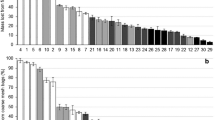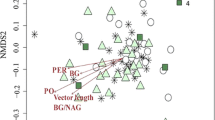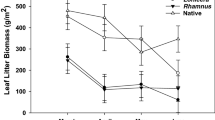Summary
The microarthropod community response to season, change in foliage litter quality during decomposition, and manipulated canopy herbivory by insects was measured in litterbags under 10-year-old Douglas-fir, Pseudotsuga menziesii (Mirb.) Franco, in western Oregon. Collembola accounted for 35% of the total fauna, oribatid mites for 29%, and fungivorous actinedids for 22%.
The community structure was affected by responses to canopy defoliation, season, and changes in litter quality. Of 33 taxa, three were significantly more abundant under trees subject to lepidopteran defoliation (≤20% foliage removal), compared to other treatments, indicating responses to defoliator-induced changes in litter environment. Most taxa (23) showed seasonal fluctuations in abundance related to the seasonal pattern of temperature and precipitation and to the pattern of N and Ca mobilization from litterbags. Five taxa showed significant longterm trends in abundance, indicating responses to changes in litter quality, perhaps a loss of P and K.
These data indicate that microarthropod communities respond qualitatively to environmental changes, including canopy defoliation. The qualitative changes can affeet decomposition processes.
Similar content being viewed by others
References
Box GEP (1954) Some theorems on quadratic forms applied in the study of analysis of variance problems. Ann Math Stat 25:290–302
Cepeda JG, Whitford WG (1989) The relationship between abiotic factors and the abundance patterns of soil microarthropods on a desert watershed. Pedobiologia 33:79–86
Conover WJ, Iman RL (1981) Rank transformation as a bridge between parametric and nonparametric statistics. Am Stat 35:124–129
Fogel R, Cromack K Jr (1977) Effect of habitat and substrate quality on Douglas-fir litter decomposition in western Oregon. Can J Bot 55:1632–1640
Gholz HL, Hawk GM, Campbell A, Cromack K Jr (1985) Early vegetation recovery and element cycles on a clear-cut watershed in western Oregon. Can J For Res 15:400–409
Greenhouse SW, Geisser S (1959) On methods in the analysis of profile data. Psychometrika 24:95–112
Milliken GA, Johnson DE (1984) Analysis of messy data. Vol. 1: Designed experiments. Lifetime Learning Publications, Belmont, California
Moldenke AR, Fichter BL (1988) Invertebrates of the H. J. Andrews Experimental Forest, Western Cascade Mountains, Oregon: IV. The Oribatid Mites (Acari: Cryptostigmata) USDA Forest Service General Technical Report PNW-GTR-217, Pacific Northwest Research Station, Portland, Oregon
Moore JC, Walter DE, Hunt HW (1988) Arthropod regulation of micro- and mesobiota in below-ground detrital food webs. Annu Rev Entomol 33:419–439
Moore JC, Hunt HW, Elliott ET (1991) Interactions between soil organisms and herbivores. In: Barbosa P, Kirschik V, Jones C (eds) Multitrophic-level interactions among microorganisms, plants, and insects. John Wiley, New York
Santos PF, Whitford WG (1981) The effects of microarthropods on litter decomposition in a Chihuahuan desert ecosystem. Ecology 62:654–663
SAS Institute (1982) SAS user's guide: Statistics. SAS Institute, Cary, North Carolina
Schowalter TD, Hargrove WW, Crossley DA Jr (1986) Herbivory in forested ecosystems. Annu Rev Entomol 31:177–196
Schowalter TD, Sabin TE, Stafford SG, Sexton JM (1991) Phytophage effects on primary production, nutrient turnover, and litter decomposition of young Douglas-fir in western Oregon. For Ecol Manage (in press)
Seastedt TR (1984) The role of microarthropods in decomposition and mineralization processes. Annu Rev Entomol 29:25–46
Seastedt TR, Crossley DA Jr (1983) Nutrients in forest litter treated with naphthalene and simulated throughfall: a field microcosm study. Soil Biol Biochem 15:159–165
Seastedt TR, Ramundo RA, Hayes DC (1988) Maximization of densities of soil animals by foliage herbivory: Empirical evidence, graphical and conceptual models. Oikos 51:243–248
Seastedt TR, Reddy MV, Cline SP (1989) Microarthropods in decaying wood from temperate coniferous and deciduous forests. Pedobiologia 33:69–77
Walter DE (1985) The effects of litter type and elevation on colonization of mixed coniferous litterbags by oribatid mites. Pedobiologia 28:383–387
Author information
Authors and Affiliations
Rights and permissions
About this article
Cite this article
Schowalter, T.D., Sabin, T.E. Litter microarthropod responses to canopy herbivory, season and decomposition in litterbags in a regenerating conifer ecosystem in Western Oregon. Biol Fertil Soils 11, 93–96 (1991). https://doi.org/10.1007/BF00336370
Received:
Issue Date:
DOI: https://doi.org/10.1007/BF00336370




